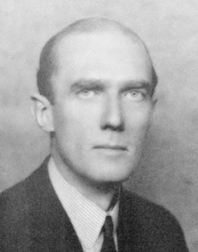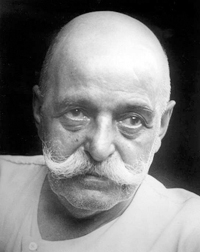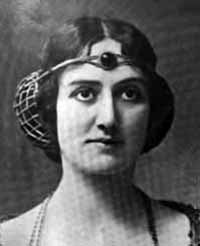Printed in the Spring 2015 issue of Quest magazine.
Citation: Ginsburg, Seymour B."A Teacher of Dancing: The Mahatma Letters and Gurdjieff" Quest 103.2 (Spring 2015): pg. 58-60.
By Seymour B. Ginsburg
 There is a little-known story about Maud Hoffman, the owner of the documents known as the Mahatma Letters, and A. Trevor Barker, the transcriber and compiler of the letters. Hoffman and Barker brought the letters to publication in December 1923. While both were ardent Theosophists, they were at the same time pupils of the spiritual teacher G.I. Gurdjieff (1866?—1949). They resided with him at his school in France during much of the fifteen-month period immediately prior to the letters" publication. Hoffman continued as a residential pupil into 1924. This is that story.
There is a little-known story about Maud Hoffman, the owner of the documents known as the Mahatma Letters, and A. Trevor Barker, the transcriber and compiler of the letters. Hoffman and Barker brought the letters to publication in December 1923. While both were ardent Theosophists, they were at the same time pupils of the spiritual teacher G.I. Gurdjieff (1866?—1949). They resided with him at his school in France during much of the fifteen-month period immediately prior to the letters" publication. Hoffman continued as a residential pupil into 1924. This is that story.
On March 30, 1883, Alfred Percy Sinnett, with his wife, Patience, and their son, Dennie, sailed from Madras, India, for Europe, reaching England on April 26, 1883. Sinnett had finished his assignment as editor of a large English-language daily in India, The Pioneer, at which he had been employed since 1872.
During his final years in India from 1880 to 1883, Sinnett engaged in extensive correspondence with two of H.P. Blavatsky"s teachers, whom she called the Master Morya (M.) and the Master Koot Hoomi (K.H.). Almost all of these letters were received in India. Most were sent to Sinnett before he departed for England. The correspondence continued through 1884, with Sinnett receiving several more letters after his arrival in England. Several of those received in England are signed by Blavatsky rather than by M. or K.H., and several more are fragments. The letters, compiled by Barker, are numbered 1 through 145, plus eight that are labeled as subparts of a letter, giving a total of 153 letters. These were collected and stored by Sinnett in two wood and metal boxes. They have become known as the Mahatma Letters.
Patience Sinnett died in 1908, and Dennie, soon after. Sinnett was left without any direct heirs. In 1910, living in England, he met and became friends with Maud Hoffman, an American Shakespearean actress and Theosophist. Hoffman at the time shared an apartment with Mabel Collins, channel for the Theosophical classic: the occultly transmitted Light on the Path.
In April 1919, Sinnett received an honorarium presented to him by Harold Baillie-Weaver, a barrister and prominent member of the Theosophical Society, at a house at 146 Harley Street, London. At that time Hoffman resided at that address along with Dr. Maurice Nicoll and Dr. James Young, who also used the house for their psychiatric practices. The three of them also jointly owned a weekend cottage at Chorley Wood, Buckinghamshire, where Dr. C.G. Jung and Dr. Kenneth Walker stayed as guests. Jung also stayed at 146 Harley Street. Both Nicoll and Walker would later become major exponents of Gurdjieff"s teaching.
In June 1921, Sinnett died in London. Hoffman, who had tended him during his last illness, was named executrix of his estate and his sole legatee. He bequeathed the letters he had accumulated to Hoffman "solely and unconditionally." Hoffman thereby became owner of the Mahatma Letters.
In August 1921, P.D. Ouspensky arrived in London from Constantinople. Ouspensky, a professional journalist and amateur mathematician, had already become well-known in the West through his book Tertium Organum, a speculative treatise on the higher dimensions of time. Ouspensky was Gurdjieff"s most prominent pupil, having met him in Moscow in 1915. In 1917, together with Ouspensky and several other pupils, Gurdjieff fled Russia and the Bolsheviks on a long and harrowing journey over the Caucasus mountains. Gurdjieff wanted to establish a spiritual school and attempted this at several locations including Tbilisi, the capital of Georgia, and then Constantinople, before going on to Europe.
Lady Rothermere, wife of a British press baron, had an interest in spirituality. She financed Ouspensky"s travel from Constantinople to London, where he began to lecture on Gurdjieff"s teaching at the rooms of the Theosophical Society. In October 1921, Barker, Hoffman, Nicoll, Walker, Young, and others became pupils of Ouspensky after hearing his lectures.
In February 1922, Gurdjieff arrived in London. But unlike Ouspensky, who would make England his home, Gurdjieff stayed in England only temporarily on his way to France. Barker, Hoffman, Nicoll, and Young, among other followers of Ouspensky, heard Gurdjieff speak in the Theosophical Society"s rooms on February 13, 1922, and again in March. Impressed with Gurdjieff, they became his pupils, transferring from Ouspensky. That autumn they would follow Gurdjieff to France, where he had next decided to establish his spiritual school.
In August 1922, Hoffman decided to make the Mahatma Letters public and chose as their transcriber and compiler her friend and fellow Theosophist, Alfred Trevor Barker. Barker would work on the letters over the next fifteen months.
In September 1922, having sent his secretary, Olga de Hartmann, ahead to make arrangements, Gurdjieff leased the Château du Prieuré des Basses Loges at Fontainebleau-Avon, thirty-five miles south of Paris, as the site for his residential spiritual school. Barker went over to France, and with Young and the wives of Gurdjieff and Ouspensky began to work there to prepare the school to receive pupils. Maud Hoffman arrived soon after. Barker was already working on transcribing and compiling the Mahatma Letters. For much of the time from September 1922 through November 1923, when Barker was transcribing and compiling the letters, both he and Hoffman resided at the Prieuré with their teacher, Gurdjieff.
 |
 |
 |
| A. Trevor Barker | G.I. Gurdjieff | Maud Hoffman |
In October 1922, Katherine Mansfield, the celebrated young New Zealand writer, came to live at the Prieuré, hoping that Gurdjieff, who was known as a healer among his other talents, could cure her of tuberculosis. This was not to be, and Mansfield died in January 1923. Her letter to John Middleton Murray of November 19, 1922 confirms Barker"s continued residence at the Prieuré during that time, as does the unpublished journal of Ethel Merston, who ran the Prieuré for Gurdjieff as its manager from 1922 to 1927.
In November 1922, Gurdjieff"s Institute for the Harmonious Development of Man officially opened its doors at the Prieuré. In that same month Nicoll brought his wife and baby to live with him there. In the summer of 1923, while at Gurdjieff"s school, Hoffman wrote an article for The New York Times describing the activities there: "During this last summer, the inhabitants of Fontainebleau and Avon, in France, and the summer visitors at the hotels, flocked to the old Prieure des Basses Loges to see the Saturday evening demonstrations of the work done there by the pupils of the Gurdieff Institute." This article, a lengthy two-column affair, gives a colorful description of life at Gurdjieff"s school as experienced by Hoffman, Barker, Nicoll, and other pupils during 1923. The article was published on February 10, 1924.
During this period, as previously, Gurdjieff criticized the behavior of Theosophists and the Theosophical Society. His criticisms had mainly to do with the Theosophists" drift toward spiritualism, and several of his criticisms found their way into his published writings going back to 1918.
Barker echoed these criticisms in repeating the Master K.H."s complaints, particularly about spiritualism and psychic phenomena, in which many Theosophists of his time were engaged. In the introduction to the first edition of The Mahatma Letters, Barker emphasizes the dim view that the Master K.H. took of the behavior of some Theosophists in this regard even as early as 1881. He quotes K.H., who expresses his views in letters 45 and 49: "There has been a noticeable tendency also for sections of the Society to drift towards what Master K.H. calls "˜the most insane and fatal of superstitions"”Spiritualism." In another letter K.H. says, "˜A psychic Society is being founded . . . it will grow and develop and expand and finally the Theos. Soc. of London will be swamped in it, and lose first its influence then"”its name"”until Theosophy in its very name becomes a thing of the Past." It is regrettable that these words are as true today [1923] as when they were written" (Barker, xv; emphasis in the original).
Barker would resign his membership in the TS in 1926. One of his last actions was arranging for the depositing in 1939 of the originals of the letters in the British Museum"s Department of Select Manuscripts. After Barker"s death in 1941, Christmas Humphreys and Elsie Benjamin were appointed trustees of the letters.
These events, beginning with the receipt of the first Mahatma Letter by Sinnett in October 1880, his bringing the letters to England in 1883, his subsequent transfer of their ownership to Maud Hoffman at his death in 1921, their transcription and compilation by Trevor Barker in 1922—23, and their publication in December 1923, are now relegated to the annals of history. That Hoffman and Barker were pupils of Gurdjieff, living with him in France for part of 1922, most of 1923, and early 1924, is part of that history.
It is now 2015, more than a hundred years since Gurdjieff emerged from Central Asia and began in Moscow teaching the method of practical work as predicted by HPB in The Secret Doctrine:
In Century the Twentieth some disciple more informed and far better fitted, may be sent by the Masters of Wisdom to give final and irrefutable proofs that there exists a Science called Gupta-Vidya [esoteric or secret science], and that, like the once-mysterious sources of the Nile, the source of all religions and philosophies now known to the world has been for many ages forgotten and lost to men, but is at last found. (Blavatsky, 1:xxxviii)These two volumes [of The Secret Doctrine] should form for the student a fitting prelude for Volumes III. and IV. Until the rubbish of the ages is cleared away from the minds of the Theosophists to whom these volumes are dedicated, it is impossible that the more practical teaching contained in the Third Volume should be understood. (Blavatsky 2:797—98)
Modern Theosophy is based upon two sets of core documents: (1) The Stanzas of Dzyan, transmitted occultly to HPB by Morya and Koot Hoomi, and around which she wrote The Secret Doctrine, and (2) The Mahatma Letters. That Gurdjieff was aware of the work of transcribing, compiling, and publishing of these letters by Hoffman and Barker is evidenced by the fact that they were Gurdjieff"s pupils, residing with him at the Prieuré during the months in which their work with the Mahatma Letters was taking place.
Of the connection between Gurdjieff and HPB and her teachers, Walker wrote:
Indeed, in most European circles Gurdjieff was regarded not so much as a philosopher, but as one of the greatest living experts on the sacred dances of the East. What may be of interest to many readers is that in a letter written by Madame Blavatsky to one of the early members of the Theosophical Society, she foretells that the next great teacher of Eastern ideas in Europe will be an instructor in Oriental dancing. (Walker, 152)
Is Gurdjieff, then, one of the group of Masters who constitute the occult hierarchy behind the Theosophical Society? Sri Madhava Ashish and his teacher, Sri Krishna Prem, thought so. Ashish and Prem were knowledgeable Theosophists. They authored two books of commentary on the Stanzas of Dzyan"”Man, The Measure of All Things and Man, Son of Man"” that are widely used by groups studying The Secret Doctrine. Devoted to Theosophical study, they also engaged in practical Theosophical work at their Mirtola ashram in the Indian Himalayas. They honored Gurdjieff as the disciple predicted by HPB who would bring the practical teaching in the twentieth century.
In a letter of December 12, 1988 to this writer, Ashish wrote: "The particular characteristic of the TS is its direct inspiration by the Masters or bodhisattvas. They fielded HPB and stood by her all her life. G was one of them, which is why his teaching is in the same tradition" (in Ginsburg, 129).
Sources
Ashish, Sri Madhava. Man, Son of Man. Wheaton: Theosophical Publishing House, 1970.
Barker, A.T. The Mahatma Letters. 1st ed. London: Rider, 1923.
Blavatsky, H.P. The Secret Doctrine. Facsimile of the original edition of 1888; two volumes published as one. Los Angeles: The Theosophy Company, 1982.
Ginsburg, Seymour B. The Masters Speak: An American Businessman Encounters Ashish and Gurdjieff. Wheaton: Quest Books, 2010.
Gurdjieff, G.I. Beelzebub"s Tales to His Grandson. New York: Penguin, 1999.
Gurdjieff, G.I. Views from the Real World. New York: Dutton, 1975.
Hoffman, Maud. "Taking the Life Cure in Gurdjieff"s School," New York Times, Feb. 10, 1924.
Korman, Mary E. A Woman"s Work: The Spiritual Life Journey of Ethel Merston. Fairfax, Calif.: Arete, 2009.
Moore, James. "The Blavatsky-Gurdjieff Question: A Footnote on Maude [sic] Hoffman and A.T. Barker," Theosophical History, July 1990.
Pogson, Beryl. Maurice Nicoll: A Portrait. New York: Fourth Way Books, 1987.
Prem, Sri Krishna, and Sri Madhava Ashish. Man, the Measure of All Things. Wheaton: Theosophical Publishing House, 1969.
Walker, Kenneth. A Study of Gurdjieff "s Teaching. London: Jonathan Cape, 1957.
Seymour B. (Sy) Ginsburg is author of The Masters Speak: An American Businessman Encounters Ashish and Gurdjieff (Quest Books). He edited Sri Madhava Ashish"s article "Mirtola: A Himalayan Ashram with Theosophical Roots' for the Summer 2012 issue of Quest magazine.

